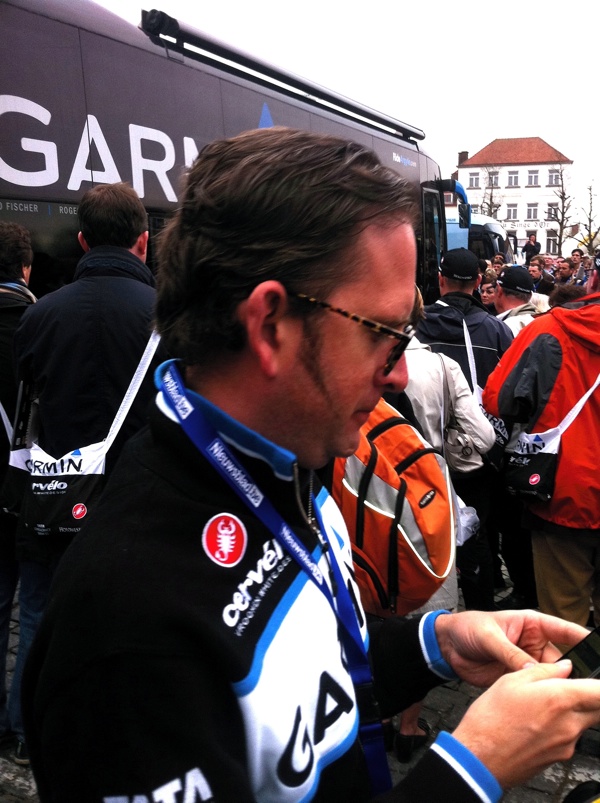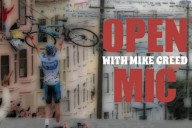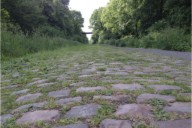As a cyclist of less than two years vintage, one of my aims for 2011 was to have a stab at road racing. I cannot exactly explain why I wanted to race – I was mediocre at best at all sports as a youngster and I was not in any way athletically-gifted. Other than on the very rare occasions when I entered a berserk-like trance on the sports field, my performances were always sub-par. I would spend my time wishing the ball away and the clock to run down. I think that my main problem is that I am just not a competitive person and I am way too passive – compared to me, Andy Schleck seems like Rambo, on steroids.
Anybody who has read a cycling biography will know that the embryonic careers of the protagonists follow a similar pattern – they normally do not win their first race or two, become slightly disheartened, decide that if they don’t quickly start winning then they are going to go back to their lives as vegetable pickers, welders or farmers so as to earn a stable wage. They then usually make good and win the next twenty races before turning professional and have stellar careers. Like me, all of those who turn out Sunday morning after Sunday morning already have stable employment, families and/or other serious time commitments. As I was to quickly discover, we do what we do not because of the prospect of victory but because of the beauty and brutality of the bike – we enjoy the suffering and cling to the slender prospect of victory. In reality, most of us have no chance of winning but as the line from White Men Can’t Jump goes, “the sun even shines on a dog’s ass some days” and that thought keeps us going.
I am not sure what the name is for a group of racing cyclists and their entourage congregating before and after a race. The slightly more glamorous world of Formula One uses the term “paddock.” As an outsider, my first experience of the cycling paddock was one of wonderment and intimidation. Pretty much all of the other guys there were skinnier than me. I am over 6′ and as lean as I can be at 75kg but there were guys taller than me who weighted much less, with practically no waists. That is without even mentioning the smaller and much lighter guys – the size zeros. The heroin-chic look of sunken jaws and eye sockets may not be en vogue on the catwalk but amongst racing cyclists it is alive and well.
It didn’t take very long to discover that a typical start field in a race comprised of 4 distinct groups:
- The gifted cyclist: ex-elite and higher category riders who for whatever reason have taken some time out of cycling and are starting again at the bottom of the ladder. Amongst this group is a teammate of mine – an ex-first category rider who raced in France and is now re-ascending the ladder. One other notable person falling into this category is a veteran rider from the continent who raced professionally for many years;
- The ‘quote’ masters: so called because, as juniors, they are described as “master” rather than “mister” on the race start sheet. These are the very talented kids – young men in a hurry – who are blitzing through the ranks and will in all probability go on to race at a consistently high level;
- The gifted endurance athletes: typically decommissioned middle-distance runners with dodgy knees or other ailments but who invariably take to the bike with ease; and
- Everybody else: if we were a political constituency, we would be the “squeezed middle.” We are the guys who are some of the fastest at our respective clubs but are utterly unremarkable when it comes to racing – cannon fodder – and it is our job to make the other guys look good. When the planets align, we are capable of winning but that doesn’t happen very often.
As most races started between 8-9 am on a Sunday morning in locations of up to two hours drive away, once you factored in the need to be there around an hour beforehand to sign-on and set up your bike, this meant an extremely early alarm call. Soccerballer and pampered professional Wayne Rooney was recently complaining on Twitter about the awfulness of midday kick-offs as it meant having to “shovel pasta” into himself at 9 am. Whereas Rooney is getting paid £250,000 per week just to play football and shovel pasta, those of us downing muesli at little after 5am on a Sunday morning are doing it all for the love of the sport and nothing more. On many a Sunday morning I seriously considered going back to bed after the alarm went off but happily I never gave into temptation. I was normally well on the road by the time the sweet spot between night and morning arrived – that period between revelers heading to after-club house parties and before the morning-after walks of shame begin. Ah, the nostalgia!
My first race was one to forget – a criterium in a very random location. As I had no idea what to expect, I was very nervous beforehand (bizarrely this was the one and only time I suffered with nerves before a race). As the race location was new to all of the riders, we did a formation lap to familiarise ourselves. I was very shocked to see that everybody was going full tilt – there were times we were going 55kmph. Getting dropped even before a race began must be some sort of record! The race itself wasn’t a whole lot better. I got a puncture 15 minutes in, and since I didn’t know the rules I didn’t bring spare wheels, so was unable to take a lap out and return. In summation, a more than two-hour drive to the venue, a twenty-minute warm up, then a two-hour drive back again punctuated by 15 minutes of futile racing.
Races two, three and four weren’t much better – a DNF due to a flat plus another DNF due to my chain breaking (down to my own shoddy mechanics) plus some bad cornering on a crit. After those first four races, I was seriously thinking that my time would indeed be better spent picking fruit or welding. However, I knew that if my luck turned and I managed to avoid mechanicals, I was probably good enough to finish in the bunch. Turning my luck involved buying a new set of racing wheels and having my bike properly serviced at my local bike shop.
Thereafter, apart from punctuation due to holidays, I managed to get a fairly consistent run of races and some form. The first few proper races were spent attuning myself to racing rhythm – going from cruising in the pack to all out for periods of time to back again to short sharp sprints. This meant paying attention at all times and anticipating surges and slowdowns. In general – but not always – as I got better I would finish fairly consistently somewhere between 15-25. Not too bad but at the same time not at the pointy end of things. At this level, most races tend to finish on long uphill drags – not because there is an abundance of punchy riders who love hills but because logistically the organisers cannot cope with a bunch sprint finish – being unable to allocate places when a lot of people cross the line together. As I am more Greipel than Gilbert in terms of finishing straight preferences (if not looks), only a couple of finishes really suited me. So the only way to avoid having to slug it out with a 65kg lightweight up the long finishing hills was to get in a break. As I got a little bit more confident, I tried getting into a few breaks but all were short-lived and unsuccessful.
I managed to pick up some points as the season went on – finishing fifth in a couple of races– so I went from fourth to third cat racing licence, which was the minimum target I set myself at the start of the season if I were to make a fist of the racing. This means that I will not start at the very bottom of the pile next year and any points gained will go towards earning a second cat licence.
I think that at my level – all things being equal – the biggest deciders in most races are not legs but race smarts and being able to be in the right place at the right time. As I got further through the summer, I found it a little easier to read races or to anticipate attacks (this also meant watching races on television was more enjoyable). For example, getting early to the race and seeing who has signed on and at what time leads one to suspect that the person in question is off for a hard warm up and is going to be in an early break. At our level, attacks were generally telegraphed – invariably somebody would go right before a village or a junction where the road narrowed so the bunch would have to go slower and avoid traffic hazards. Inattention cost me in a few early races – being overgeared at the wrong time, not remembering the course. Another good tip I found was to watch those riders from the race host club carefully – they know the course very well and know when to move up through the bunch and where the optimum position at any given time is.
I was still racing as October approached and my body felt good. I thought that there was no reason why I should significantly dial down my training over the winter by taking a rest. I was even thinking that it might be worth racing cyclocross, and didn’t understand why anybody might need extended time away from the bike. I had a very enjoyable race the first weekend of October and then in the following days, my form went off a cliff. I was schedule to ride my last race of the year the following weekend – a local race – but I did no training between events. As I set off on my bike to ride to the race HQ that morning I knew that I was in for a bad day – I was benchmarking myself on a local hill en route and found that with the same effort as normal, I was going 5kmph slower. That was a pretty big drop off. Needless to say, the race was bit of a disaster with the second cats ripping the legs off the rest of us from the flag drop.
After that, I more or less took October off the bike – with the exception of a few leisurely weekend rides. My wife was genuinely puzzled/amazed that I left my bike in the car for almost a week without touching it. When I was out on the road last weekend I felt good again and well rested. The next thing I need to do is to set up the dreaded turbo trainer and mentally prepare for many tedious hours in my shed. Subconsciously, I think part of the need to take an extended break was that I know if I want to be competitive next year, I am going to have to put in a lot of hard work and work on my weaknesses between now and next spring. There will be suffering and lots of it. I also think that if I am ever to win a race, I will need to be aggressive and channel my inner berserk a bit more. Maybe Mr. Andy and I can share a sports psychologist.
Some top tips for racing: always bring a recovery drink and bottled water for afterwards, always bring spare safety pins for attaching your number in case there are none at the race HQ, and always make sure that you go to the toilet pre-race at a service station near the race HQ. The first two tips should be self-explanatory. The last, less so. Let me tell you that 59 (or 119 if there are two races) other cyclists trying to empty their bowels in a thirty-minute window before a race in a building with only one decrepit toilet is not a pleasant experience.
So what of the elephant in the room, le dopage? Once you are on the “inside” you do see fairly blatant juicing – beetroot juicing. Clearly there are some guys out there who have bought into the Chris Horner mountain-ascending-miracle-elixir mystique. It wasn’t unusual to see guys wandering around after sign-on sipping beetroot juice or to see discarded bottles of the stuff in their cars after races. A slippery slope no doubt, but thankfully I didn’t see any white lunch bags or Lim rice cakes. Maybe thats how the first and second cat cats roll.
In summary, I thoroughly enjoyed my first season racing. Nothing can beat that feeling on a good day where you are bombing along effortlessly, your legs spinning but you are in such a good place that you cannot even feel them. There were a few unexpectedly tough races, but for the most part, all were fine. If you are on the fence about taking the racing plunge and if you can make the necessary time commitment, give it a go. In the long term, nobody ever got slower by racing.
Although most of my year was spent racing, I did get up to other cycling-related things. No season retrospective would be complete without some awards, so here we go with some random categories:
- Best and Worst Day on a Bike: Gran Fondo Milan–San Remo in early June. 298km in mostly torrential rain. Two punctures, a broken pump, and no inner tubes left after that. Having to borrow a pump from a benevolent Belgian and then find him again later in the event. Notwithstanding this, it was an awesome day – from the lightning-fast exit of Milan to thunder and lightning on the Poggio and Cipressa;
- Bat out of Hell Fastest Descent Award: Mont Ventoux in late July. It was nice and sunny on the way up, then cloud rolled in at the top and I began heavily coughing due to the cold air. It then started to rain so I had to get down to the warmth of Bedoin again. I don’t think I dipped under 70kmph on the whole way down;
- Toughest Climb: Mortirolo, the classic ascent. If you have tackled this climb, you know what I am talking about. If you haven’t, you don’t want to know;
- Biggest Racing Chump of the Year: A tie between (a) the prototype guy who thinks that if it was OK for Fignon to attack during the feed zone back in the day, then it is OK for him to attack (in a lowly amateur race) on the wrong side of the road into incoming traffic when the rest of the bunch is squeezed in so as to let the oncoming car pass; and (ii) the gobby guy who starts and ends the season as a fourth cat but that doesn’t get in the way of him chiding others about their riding lines or pushing/leaning on other cyclists during a race;
- The ‘I’m-Just-Going-out-for-an-Hour-for-a-Quick-Spin’ Award: On a family holiday in France, getting terribly lost and arriving back 170km later to a fuming wife. I had to voluntarily ground myself for a couple of days just to be allowed back out on the bike again;
- Most Unexpectedly Pleasant Day: Racing in early October in 27 degrees celsius (80f) on a nice circuit with sea views. Global warming, hell yeah!
- The Revenge is Sweet Award: Working in a crit with a guy out on our own in fifth and sixth positions, alternating pulls at the front and then, as we approached the last lap, being jumped by him once I had done my pull. I managed to reel him with about 50 meters to go;
- The Most Humbling Moment Award: Abruptly having to stop the car in a country lane and empty my bowels in a hedgerow on the way to a race. My ‘one service station before race HQ’ rule (see above) failed me badly. Like that often-quoted graduation speech about sunscreen: if I could offer you only one tip for the future, wetwipes would be it;
- The ‘Beta is Beta For a Reason’ Award: Switching from iPhone to Android and ditching my TomTom in favour of Google Navigation satnav – a navigation system very clearly labelled as being in beta state so as a result not wholly reliable. Missing my turn-off for the race due to poor lane signaling, the phone not being able to update the navigation to provide an alternative route, so consequently not being able to get off the motorway but having the ignominy of driving over the flyover under which the race started. Ending up in a service station about 30 miles away and missing the race entirely;
- Strangest Cycling Picture of the Year Taken by Me: Vaughters preparing an undoubtedly snarky tweet in advance of the Tour of Flanders:















No Comments